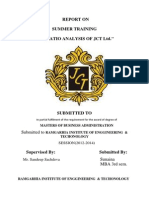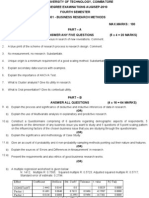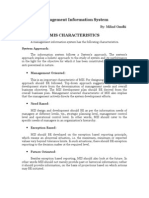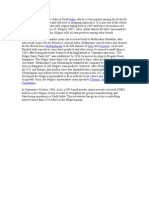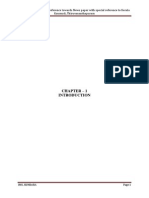Data Analytics 2marks PDF
Uploaded by
shobanaData Analytics 2marks PDF
Uploaded by
shobanaIT6006 – DATA ANALYTICS
QUESTION BANK
What are the uses of statistics in data analytics?
Statistics is used to
• to estimate the complexity of a data mining problem;
• suggest which data mining techniques are most likely to be successful; and
• identify data fields that contain the most “surface information”.
m
What are the factors to be considered while selecting the sample in statistics?
The sample should be
• Large enough to be representative of the population.
.co
• Small enough to be manageable.
• Accessible to the sampler.
• Free of bias.
Name some advanced database systems.
lts
Object-oriented databases, Object-relational databases.
Name some specific application oriented databases.
• Spatial databases,
• Time-series databases.
u
• Text databases and multimedia databases.
res
Define Relational databases.
A relational database is a collection of tables, each of which is assigned a unique name.
Each table consists of a set of attributes (columns or fields) and usually stores a large set
of tuples (records or rows). Each tuple in a relational table represents an object identified
by a unique key and described by a set of attribute values.
y2
Define Transactional Databases.
A transactional database consists of a file where each record represents a transaction. A
Transaction typically includes a unique transaction identity number (trans_ID), and a list
2b
of the items making up the transaction.
Define Spatial Databases.
Spatial databases contain spatial-related information. Such databases include geographic
(map) databases, VLSI chip design databases, and medical and satellite image databases.
Spatial data may be represented in raster format, consisting of n-dimensional bit maps or
pixel maps.
IT6006-DATA ANALYTICS Dr.M.RAJESH BABU Prof/CSE
What is Temporal Database?
Temporal database store time related data .It usually stores relational data that include
time related attributes. These attributes may involve several time stamps, each having
different semantics.
What are Time-Series databases?
A Time-Series database stores sequences of values that change with time, such as data
Collected regarding the stock exchange.
Why machine learning is done?
1. To understand and improve the efficiency of human learning.
m
2. To discover new things or structure that is unknown to human beings.
3. To fill in skeletal or computer specifications about a domain.
.co
Give the components of a learning system.
1. Critic
2. Sensors
3. Learning Element
4. Performance Element
5. Effectors
lts
6. Problem generators.
What are the steps in the data mining process?
u
Data cleaning
Data integration
Data selection
res
Data transformation
Data mining
Pattern evaluation
Knowledge representation
y2
Define data cleaning.
Data cleaning means removing the inconsistent data or noise and collecting
necessary information
2b
Define data mining.
Data mining is a process of extracting or mining knowledge from huge amount of data.
Define pattern evaluation.
Pattern evaluation is used to identify the truly interesting patterns representing knowledge
based on some interesting measures.
IT6006-DATA ANALYTICS Dr.M.RAJESH BABU Prof/CSE
Define knowledge representation.
Knowledge representation techniques are used to present the mined knowledge to the
user.
What is Visualization?
Visualization is for depiction of data and to gain intuition about data being observed. It
Assists the analysts in selecting display formats, viewer perspectives and data
representation schema
Define Spatial Visualization.
Spatial visualization depicts actual members of the population in their feature space
m
What is Descriptive and predictive data mining?
Descriptive data mining describes the data set in a concise and summertime manner and
.co
Presents interesting general properties of the data. Predictive data mining analyzes the
data in order to construct one or set of models and attempts to predict the behavior of new
data sets.
What is Data Generalization?
lts
It is process that abstracts a large set of task-relevant data in a database from a relatively
low conceptual to higher conceptual levels 2 approaches for Generalization
a. Data cube approach
b. Attribute-oriented induction approach
u
Define Attribute Oriented Induction.
These method collets the task-relevant data using a relational database query and then
res
perform generalization based on the examination in the relevant set of data.
What is bootstrap?
An interpretation of the jack knife is that the construction of pseudo value is based on
Repeatedly and systematically sampling with out replacement from the data at hand. This
y2
lead to generalized concept to repeated sampling with replacement called bootstrap.
Explain the view of statistical approach.
Statistical method is interested in interpreting the model. It may sacrifice some
2b
performance to be able to extract meaning from the model structure. If accuracy is
acceptable then the reason that a model can be decomposed in to revealing parts is often
more useful than a 'black box' system, especially during early stages of investigation and
design cycle.
IT6006-DATA ANALYTICS Dr.M.RAJESH BABU Prof/CSE
Define Deterministic models.
Deterministic models, which takes no account of random variables, but gives precise,
fixed reproducible output.
Define Systems and Models.
System is a collection of interrelated objects and Model is a description of a system.
Models are abstract, and conceptually simple.
How do you choose the best model?
All things being equal, the smallest model that explains the observations and fits the
objectives that should be accepted. In reality, the smallest means the model should
m
optimizes a certain scoring function (e.g. Least nodes, most robust, least assumptions)
.co
What is clustering?
Clustering is the process of grouping the data into classes or clusters so that objects
within a cluster have high similarity in comparison to one another, but are very dissimilar
to objects in other clusters.
lts
What are the requirements of clustering?
• Scalability
• Ability to deal with different types of attributes
• Ability to deal with noisy data
u
• Minimal requirements for domain knowledge to determine input parameters
• Constraint based clustering
• Interpretability and usability
res
State the categories of clustering methods.
Partitioning methods
Hierarchical methods
Density based methods
y2
Grid based methods
Model based methods
2b
What is linear regression?
In linear regression data are modeled using a straight line. Linear regression is the
simplest form of regression. Bivariate linear regression models a random variable Y
called response variable as a linear function of another random variable X, called a
predictor variable.
Y=a+bX
IT6006-DATA ANALYTICS Dr.M.RAJESH BABU Prof/CSE
State the types of linear model and state its use.
Generalized linear model represent the theoretical foundation on which linear regression
can be applied to the modeling of categorical response variables. The types of generalized
linear model are
Logistic regression
Poisson regression
Write the preprocessing steps that may be applied to the data for classification and
prediction.
a. Data Cleaning
b. Relevance Analysis
c. Data Transformation
m
Define Data Classification.
It is a two-step process. In the first step, a model is built describing a pre-determined set
.co
of data classes or concepts. The model is constructed by analyzing database tuples
described by attributes. In the second step the model is used for classification.
What is a “decision tree”?
It is a flow-chart like tree structure, where each internal node denotes a test on an
lts
attribute, each branch represents an outcome of the test, and leaf nodes represent classes
or class distributions. Decision tree is a predictive model. Each branch of the tree is a
classification question and leaves of the tree are partition of the dataset with their
classification.
u
Where are decision trees mainly used?
Used for exploration of dataset and business problems Data preprocessing for other
res
predictive analysis Statisticians use decision trees for exploratory analysis
What is Association rule?
Association rule finds interesting association or correlation relationships among a large
y2
set of data items, which is used for decision-making processes. Association rules analyzes
buying patterns that are frequently associated or purchased together.
Define support.
2b
Support is the ratio of the number of transactions that include all items in the antecedent
and consequent parts of the rule to the total number of transactions. Support is an
association rule interestingness measure.
IT6006-DATA ANALYTICS Dr.M.RAJESH BABU Prof/CSE
Define Confidence.
Confidence is the ratio of the number of transactions that include all items in the
consequent as well as antecedent to the number of transactions that include all items in
antecedent. Confidence is an association rule interestingness measure.
How is association rules mined from large databases?
Association rule mining is a two-step process.
Find all frequent itemsets.
Generate strong association rules from the frequent itemsets.
What is the classification of association rules based on various criteria?
1. Based on the types of values handled in the rule.
m
Boolean Association rule.
Quantitative Association rule.
2. Based on the dimensions of data involved in the rule.
.co
a. Single Dimensional Association rule.
b. Multi Dimensional Association rule.
3. Based on the levels of abstractions involved in the rule.
Single level Association rule.
Multi level Association rule.
lts
4. Based on various extensions to association mining.
Maxpatterns.
Frequent closed itemsets.
u
What are the advantages of Dimensional modeling?
Ease of use.
High performance
res
Predictable, standard framework
Understandable
Extensible to accommodate unexpected new data elements and new design decisions
Define Dimensional Modeling.
y2
Dimensional modeling is a logical design technique that seeks to present the data in a
Standard framework that intuitive and allows for high-performance access. It is
inherently
Dimensional and adheres to a discipline that uses the relational model with some
2b
important restrictions.
What comprises of a dimensional model.
Dimensional model is composed of one table with a multipart key called fact table and a
set of smaller tables called dimension table. Each dimension table has a single part
primary key that corresponds exactly to one of the components of multipart key in the
fact table.
IT6006-DATA ANALYTICS Dr.M.RAJESH BABU Prof/CSE
Define a data mart.
Data mart is a pragmatic collection of related facts, but does not have to be exhaustive or
Exclusive. A data mart is both a kind of subject area and an application. Data mart is a
collection of numeric facts.
What are the advantages of a data-modeling tool?
• Integrates the data warehouse model with other corporate data models.
• Helps assure consistency in naming.
• Creates good documentation in a variety of useful formats.
• Provides a reasonably intuitive user interface for entering comments about
objects.
m
What is data warehouse performance issue?
The performance of a data warehouse is largely a function of the quantity and type of
data stored within a database and the query/data loading workload placed upon the
.co
system.
What are the types of performance issue?
1. 1.Capacity planning for the data warehouse
2. 2.data placement techniques within a data warehouse
lts
3. 3.Application Performance Techniques.
4. Monitoring the Data Warehouse.
.
u
Why do you need data warehouse life cycle process?
Data warehouse life cycle approach is essential because it ensures that the project pieces
res
are brought together in the right order and at the right time.
What are the steps in the life cycle approach?
• Project Planning
• Business Requirements definition
• Data track: Dimensional modeling, Physical Design, Data Staging Design &
y2
Development
• Technology track: Technical Architecture design, Product Selection & Installation
• Application track: End user Application Specification, End user Application
Development
2b
• Deployment
• Maintenance & Growth
• Project Management
IT6006-DATA ANALYTICS Dr.M.RAJESH BABU Prof/CSE
Merits of Data Warehouse.
• Ability to make effective decisions from database
• Better analysis of data and decision support
• Discover trends and correlations that benefits business
• Handle huge amount of data.
What are the characteristics of data warehouse?
• Separate
• Available
• Integrated
• Subject Oriented
m
• Not Dynamic
• Consistency
• Iterative Development
.co
List some of the Data Warehouse tools.
• OLAP (Online Analytic Processing)
• ROLAP (Relational OLAP)
• End User Data Access tool
• Ad Hoc Query tool
lts
• Data Transformation services
• Replication
u
Explain OLAP.
The general activity of querying and presenting text and number data from Data
res
Warehouses, as well as a specifically dimensional style of querying and presenting that is
exemplified by a number of “OLAP Vendors” .The OLAP vendors technology is no
relational and is almost always biased on an explicit multidimensional cube of data. LAP
databases are also known as multidimensional cube of databases.
y2
Explain ROLAP.
ROLAP is a set of user interfaces and applications that give a relational database a
dimensional flavour. ROLAP stands for Relational Online Analytic Processing.
2b
Explain End User Data Access tool.
End User Data Access tool is a client of the data warehouse. In a relational data
warehouse, such a client maintains a session with the presentation server, sending a
stream of separate SQL requests to the server. Eventually the end user data access tool is
done with the SQL session and turns around to present a screen of data or a report, a
graph, or some other higher form of analysis to the user. An end user data access tool can
IT6006-DATA ANALYTICS Dr.M.RAJESH BABU Prof/CSE
be as simple as an Ad Hoc query tool or can be complex as a sophisticated data mining or
modeling application.
Explain Ad Hoc query tool.
A specific kind of end user data access tool that invites the user to form their own queries
by directly manipulating relational tables and their joins. Ad Hoc query tools, as powerful
as they are, can only be effectively used and understood by about 10% of all the potential
end users of a data warehouse.
Name some of the data mining applications.
Data mining for Biomedical and DNA data analysis
Data mining for Financial data analysis
Data mining for the Retail industry
m
Data mining for the Telecommunication industry
Name some of the data mining applications.
.co
• Data mining for Biomedical and DNA data analysis
• Data mining for Financial data analysis
• Data mining for the Retail industry
• Data mining for the Telecommunication industry
lts
What is the difference between “supervised” and unsupervised” learning scheme?
In data mining during classification the class label of each training sample is provided,
this type of training is called supervised learning (i.e.) the learning of the model is
supervised in that it is told to which class each training sample belongs. Eg. Classification
u
In unsupervised learning the class label of each training sample is not known and the
member or set of classes to be learned may not be known in advance. Eg.Clustering
res
Explain the various OLAP operations.
a) Roll-up: The roll-up operation performs aggregation on a data cube, either by
Climbing up a concept hierarchy for a dimension.
b) Drill-down: It is the reverse of roll-up. It navigates from less detailed data to more
Detailed data.
y2
c) Slice: Performs a selection on one dimension of the given cube, resulting in a
Sub cube.
Why is data quality so important in a data warehouse environment?
2b
Data quality is important in a data warehouse environment to facilitate decision-making.
In order to support decision-making, the stored data should provide information from a
historical perspective and in a summarized manner.
How can data visualization help in decision-making?
Data visualization helps the analyst gain intuition about the data being observed.
Visualization applications frequently assist the analyst in selecting display formats,
IT6006-DATA ANALYTICS Dr.M.RAJESH BABU Prof/CSE
viewer perspective and data representation schemas that faster deep intuitive
understanding thus facilitating decision-making.
What do you mean by high performance data mining?
Data mining refers to extracting or mining knowledge. It involves an integration of
techniques from multiple disciplines like database technology, statistics, machine
learning, neural networks, etc. When it involves techniques from high performance
computing it is referred as high performance data mining.
Explain the various data mining issues.
Explain about
• Knowledge Mining
• User interaction
m
• Performance
• Diversity in data types
.co
Explain the data mining functionalities.
The data mining functionalities are:
• Concept class description
• Association analysis
• Classification and prediction
• Cluster Analysis
lts
• Outlier Analysis
u
Explain the different types of data repositories on which mining can be performed.
The different types of data repositories on which mining can be performed are:
res
• Relational Databases
• Data Warehouses
• Transactional Databases
• Advanced Databases
• Flat files
y2
• World Wide Web
Explain the architecture of data warehouse.
Steps for the design and construction of DW
2b
Top-down view
Data source view
Data warehouse view
Business query view
3tier DW architecture
IT6006-DATA ANALYTICS Dr.M.RAJESH BABU Prof/CSE
What is Data Mining? Explain the steps in Knowledge Discovery.
Data mining refers to extracting or mining knowledge from large amount of data. The
steps in knowledge discovery are:
Data cleaning
Data integration
Data selection
Data transformation
Data mining
Pattern Evolution
Knowledge Discovery.
Explain the data pre-processing techniques in detail.
m
The data preprocessing techniques are:
Data Cleaning
Data integration
.co
Data transformation
Data reduction
Explain the smoothing Techniques.
• Binning
• Clustering
lts
• Regression
Explain Data transformation in detail.
u
• Smoothing
• Aggregation
• Generalization
res
• Normalization
• Attribute Construction
Explain Normalization in detail.
y2
• Min Max Normalization
• Z-Score Normalization
• Normalization by decimal scaling
2b
Explain data reduction.
• Data cube Aggregation
• Attribute subset Selection
• Dimensional reduction
• Numerosity reduction
IT6006-DATA ANALYTICS Dr.M.RAJESH BABU Prof/CSE
Explain parametric methods and non-parametric methods of reduction.
Parametric Methods:
• Regression Model
• Log linear Model
Non-Parametric Methods
Sampling
Histogram
Clustering
Explain Data Discrimination and Concept Hierarchy Generation.
Discrimination and concept hierarchy generation for numerical data:
m
Segmentation by natural partitioning
Binning
Histogram Analysis
Cluster Analysis
.co
Explain Data mining Primitives.
There are 5 Data mining Primitives. They are:
• Task relevant data
• Kinds of knowledge to be mined
• Concept Hierarchies
lts
• Interesting Measures
• Knowledge Presentation and Visualization Technique to be used for Discovery
patterns
u
Explain Attribute Oriented Induction.
res
• Attribute oriented induction for data characterization
• Algorithm
• Presentation of derived generalization
• Example
y2
Explain Statistical measures in databases.
• Measuring the central tendency
• Measuring the dispersion of data
• Graph displays
2b
Explain multilevel association rule.
• Example
• Explanation
• Variations
IT6006-DATA ANALYTICS Dr.M.RAJESH BABU Prof/CSE
Explain Multidimensional Database.
• Star schema
• Snowflake schema
• Fact constellation
Explain Indexing with suitable examples.
• Bitmap Indexing
• Join Indexing
• Bitmapped join indexing
m
Explain the Back Propagation technique.
• Definition
• Back Propagation Algorithm & diagram
• Example
Explain Partition Methods.
• K-Means Partition
• K-Medoids Partition
.co
lts
• CLARANS method with examples.
Explain the types of data in cluster analysis.
u
• Data matrix
• Dissimilarity matrix
res
• Interval scaled variables
• Binary variables
• Nominal, Ordinal and Ratio scaled variables
Explain Outlier analysis.
y2
• Statistical based outlier detection
• Distance based outlier detection
• Deviation based outlier detection
2b
IT6006-DATA ANALYTICS Dr.M.RAJESH BABU Prof/CSE
You might also like
- Report File Max Landmark Group-1-Mayank Sahu - Docx Mayank SahuNo ratings yetReport File Max Landmark Group-1-Mayank Sahu - Docx Mayank Sahu68 pages
- Windows 7 SP1 Ultimate X64 3in1 OEM MULTi-24 FEB 2020 (Gen2)No ratings yetWindows 7 SP1 Ultimate X64 3in1 OEM MULTi-24 FEB 2020 (Gen2)2 pages
- Impact Analysis Checklist For Requirements Changes100% (3)Impact Analysis Checklist For Requirements Changes3 pages
- CIS 163, Fall 2013, Project 2 Connect Four Game (DRAFT)No ratings yetCIS 163, Fall 2013, Project 2 Connect Four Game (DRAFT)6 pages
- Buy ebook PRODUCTION PLANNING AND CONTROL 3rd Edition S.K. Mukhopadhyay cheap price100% (4)Buy ebook PRODUCTION PLANNING AND CONTROL 3rd Edition S.K. Mukhopadhyay cheap price81 pages
- Improving The Quality Control Measures Through Detailed Analysis of Quality Controlling Techniques in Sark Cables PVT - LT, Kanjicode, Palakkad"No ratings yetImproving The Quality Control Measures Through Detailed Analysis of Quality Controlling Techniques in Sark Cables PVT - LT, Kanjicode, Palakkad"53 pages
- Absenteeism of The Workers of The Kerala Balers Private Limited, Alappuzha.No ratings yetAbsenteeism of The Workers of The Kerala Balers Private Limited, Alappuzha.51 pages
- Opportunity in The Indian Stainless Steel Kitchen Sinks Market - Feedback OTS - 2013 PDFNo ratings yetOpportunity in The Indian Stainless Steel Kitchen Sinks Market - Feedback OTS - 2013 PDF9 pages
- A Study On Employees Motivation in TANFAC Chemicals Industries Limited Company, Cuddalore100% (1)A Study On Employees Motivation in TANFAC Chemicals Industries Limited Company, Cuddalore5 pages
- WWW - Manaresults.Co - In: 8. Case StudyNo ratings yetWWW - Manaresults.Co - In: 8. Case Study1 page
- Impact of Information Technology On Productivity: Master'S ThesisNo ratings yetImpact of Information Technology On Productivity: Master'S Thesis136 pages
- QTDM (Quantitative Techniques For Decision Making) :: An IntroductionNo ratings yetQTDM (Quantitative Techniques For Decision Making) :: An Introduction16 pages
- Effectiveness of Marketing Strategies of PVR CinemaNo ratings yetEffectiveness of Marketing Strategies of PVR Cinema59 pages
- SM-Organizational Analysis - L M PrasadNo ratings yetSM-Organizational Analysis - L M Prasad29 pages
- Mini Project of Project and Operations Research ManagementNo ratings yetMini Project of Project and Operations Research Management11 pages
- Business Analytics - The Science of Data Driven Decision MakingNo ratings yetBusiness Analytics - The Science of Data Driven Decision Making55 pages
- A Study On Brand Awareness of Parachute Coconut Oil in Tumkur100% (1)A Study On Brand Awareness of Parachute Coconut Oil in Tumkur5 pages
- A Study On Rural Consumer Behaviour Towards Selected Fast Moving Consumer Goods in Karur DistrictNo ratings yetA Study On Rural Consumer Behaviour Towards Selected Fast Moving Consumer Goods in Karur District9 pages
- To Analyze The Brand Awareness of The Product Through RetailersNo ratings yetTo Analyze The Brand Awareness of The Product Through Retailers87 pages
- Advertising Strategies of Banking Sectors in IndiaNo ratings yetAdvertising Strategies of Banking Sectors in India77 pages
- "A Study On Inventory Management" Statement of ProblemNo ratings yet"A Study On Inventory Management" Statement of Problem3 pages
- Organization Study Of: A Report Submitted in Partial Fulfillment of The Requirements For The Award of The Degree ofNo ratings yetOrganization Study Of: A Report Submitted in Partial Fulfillment of The Requirements For The Award of The Degree of6 pages
- IGNOU MBA Note On Statistics For Management100% (2)IGNOU MBA Note On Statistics For Management23 pages
- Nilgiris Is A Supermarket Chain in South India, Which IsNo ratings yetNilgiris Is A Supermarket Chain in South India, Which Is2 pages
- Casestudy:-Indian Telecom War: Startup Reliance Takes On Leader Airtel in 4G ServicesNo ratings yetCasestudy:-Indian Telecom War: Startup Reliance Takes On Leader Airtel in 4G Services7 pages
- COVID-19 A Guide to Self Preparedness for Crisis Management: 1, #2From EverandCOVID-19 A Guide to Self Preparedness for Crisis Management: 1, #25/5 (1)
- Oracle Procurement Cloud 2016 Implementation Essentials33% (3)Oracle Procurement Cloud 2016 Implementation Essentials4 pages
- Spreadsheet Information Systems Are Essential To BusinessNo ratings yetSpreadsheet Information Systems Are Essential To Business39 pages
- Acronis #CyberFit Cloud Tech Associate Advanced Security 2023 HandoutNo ratings yetAcronis #CyberFit Cloud Tech Associate Advanced Security 2023 Handout153 pages
- Salesforce Certified Administrator-Exam GuideNo ratings yetSalesforce Certified Administrator-Exam Guide6 pages
- Feedlot Wars: Software Requirements Document, Version 1 October 19, 2010No ratings yetFeedlot Wars: Software Requirements Document, Version 1 October 19, 201033 pages
- Cambridge O Level Computer Science SyllabusNo ratings yetCambridge O Level Computer Science Syllabus41 pages
- (Ebook) Build an HTML5 Game: A Developer's Guide with CSS and JavaScript by Karl Bunyan ISBN 9781593275754, 1593275757download100% (4)(Ebook) Build an HTML5 Game: A Developer's Guide with CSS and JavaScript by Karl Bunyan ISBN 9781593275754, 1593275757download46 pages
- IILM UNIVERSITY - MAKEUP-2024-25 UpdatedNo ratings yetIILM UNIVERSITY - MAKEUP-2024-25 Updated12 pages
- Accessibility: The Art of Designing For Everyone - by Omar Andani - UX CollectiveNo ratings yetAccessibility: The Art of Designing For Everyone - by Omar Andani - UX Collective14 pages
- The Hidden Enemy Within - Risk of Unmanaged DataNo ratings yetThe Hidden Enemy Within - Risk of Unmanaged Data29 pages
- Report File Max Landmark Group-1-Mayank Sahu - Docx Mayank SahuReport File Max Landmark Group-1-Mayank Sahu - Docx Mayank Sahu
- Organizational Readiness to E-TransformationFrom EverandOrganizational Readiness to E-Transformation
- Windows 7 SP1 Ultimate X64 3in1 OEM MULTi-24 FEB 2020 (Gen2)Windows 7 SP1 Ultimate X64 3in1 OEM MULTi-24 FEB 2020 (Gen2)
- Impact Analysis Checklist For Requirements ChangesImpact Analysis Checklist For Requirements Changes
- CIS 163, Fall 2013, Project 2 Connect Four Game (DRAFT)CIS 163, Fall 2013, Project 2 Connect Four Game (DRAFT)
- Buy ebook PRODUCTION PLANNING AND CONTROL 3rd Edition S.K. Mukhopadhyay cheap priceBuy ebook PRODUCTION PLANNING AND CONTROL 3rd Edition S.K. Mukhopadhyay cheap price
- Improving The Quality Control Measures Through Detailed Analysis of Quality Controlling Techniques in Sark Cables PVT - LT, Kanjicode, Palakkad"Improving The Quality Control Measures Through Detailed Analysis of Quality Controlling Techniques in Sark Cables PVT - LT, Kanjicode, Palakkad"
- Absenteeism of The Workers of The Kerala Balers Private Limited, Alappuzha.Absenteeism of The Workers of The Kerala Balers Private Limited, Alappuzha.
- Opportunity in The Indian Stainless Steel Kitchen Sinks Market - Feedback OTS - 2013 PDFOpportunity in The Indian Stainless Steel Kitchen Sinks Market - Feedback OTS - 2013 PDF
- A Study On Employees Motivation in TANFAC Chemicals Industries Limited Company, CuddaloreA Study On Employees Motivation in TANFAC Chemicals Industries Limited Company, Cuddalore
- Impact of Information Technology On Productivity: Master'S ThesisImpact of Information Technology On Productivity: Master'S Thesis
- QTDM (Quantitative Techniques For Decision Making) :: An IntroductionQTDM (Quantitative Techniques For Decision Making) :: An Introduction
- Effectiveness of Marketing Strategies of PVR CinemaEffectiveness of Marketing Strategies of PVR Cinema
- Mini Project of Project and Operations Research ManagementMini Project of Project and Operations Research Management
- Business Analytics - The Science of Data Driven Decision MakingBusiness Analytics - The Science of Data Driven Decision Making
- A Study On Brand Awareness of Parachute Coconut Oil in TumkurA Study On Brand Awareness of Parachute Coconut Oil in Tumkur
- A Study On Rural Consumer Behaviour Towards Selected Fast Moving Consumer Goods in Karur DistrictA Study On Rural Consumer Behaviour Towards Selected Fast Moving Consumer Goods in Karur District
- To Analyze The Brand Awareness of The Product Through RetailersTo Analyze The Brand Awareness of The Product Through Retailers
- Advertising Strategies of Banking Sectors in IndiaAdvertising Strategies of Banking Sectors in India
- "A Study On Inventory Management" Statement of Problem"A Study On Inventory Management" Statement of Problem
- Organization Study Of: A Report Submitted in Partial Fulfillment of The Requirements For The Award of The Degree ofOrganization Study Of: A Report Submitted in Partial Fulfillment of The Requirements For The Award of The Degree of
- Nilgiris Is A Supermarket Chain in South India, Which IsNilgiris Is A Supermarket Chain in South India, Which Is
- Casestudy:-Indian Telecom War: Startup Reliance Takes On Leader Airtel in 4G ServicesCasestudy:-Indian Telecom War: Startup Reliance Takes On Leader Airtel in 4G Services
- COVID-19 A Guide to Self Preparedness for Crisis Management: 1, #2From EverandCOVID-19 A Guide to Self Preparedness for Crisis Management: 1, #2
- Oracle Procurement Cloud 2016 Implementation EssentialsOracle Procurement Cloud 2016 Implementation Essentials
- Spreadsheet Information Systems Are Essential To BusinessSpreadsheet Information Systems Are Essential To Business
- Acronis #CyberFit Cloud Tech Associate Advanced Security 2023 HandoutAcronis #CyberFit Cloud Tech Associate Advanced Security 2023 Handout
- Feedlot Wars: Software Requirements Document, Version 1 October 19, 2010Feedlot Wars: Software Requirements Document, Version 1 October 19, 2010
- (Ebook) Build an HTML5 Game: A Developer's Guide with CSS and JavaScript by Karl Bunyan ISBN 9781593275754, 1593275757download(Ebook) Build an HTML5 Game: A Developer's Guide with CSS and JavaScript by Karl Bunyan ISBN 9781593275754, 1593275757download
- Accessibility: The Art of Designing For Everyone - by Omar Andani - UX CollectiveAccessibility: The Art of Designing For Everyone - by Omar Andani - UX Collective

























